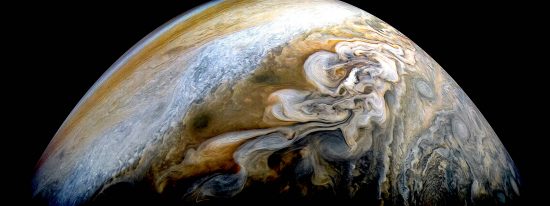Dec 14, 2018
Jupiter is the king of planets.
On August 5, 2011 NASA launched the Juno spacecraft. After a five-year flight, Juno entered orbit around Jupiter on July 4, 2016.
Jupiter is so large that all of the other planets could fit inside its 1.77 X 10^15 cubic kilometer volume. Jupiter rotates in 9.925 hours, causing its diameter to be 9275 kilometers more than the distance between its poles. As previously written, Jupiter’s moon Io dissipates more than 2 trillion watts as it revolves through Jupiter’s electromagnetic fields, proving that Jupiter is an electrically active world.
That flow of electric charge causes lightning in Jupiter’s upper atmosphere, along with aurorae at the poles. Rotating charged bodies produce dipolar electromagnetic fields, whether they are gas giants or rocky planets. Why some “hard” planets like Earth and Mercury possess magnetic fields, while Venus and Mars do not demands further investigation. However, the basic physics of charged objects in motion generating electromagnetism is not debated.
On December 21, 2018 Juno will zip past Jupiter at an altitude of 5000 kilometers at 207,287 kilometers per hour, making it the fastest object ever built. In comparison, a rifle bullet, such as a 180 grain, 30 caliber, has a muzzle velocity of 3000 kilometers per hour.
According to planetary scientists, it is convection currents that mix Jupiter’s atmosphere, creating swirling clouds and storms that are powerful enough to generate Jupiter’s magnetic field through “dynamo action.”
Dynamos were described more than a century ago. However, fluid dynamic equations are inadequate when electromagnetism and plasma environments are considered. Using models that are mechanical (kinetic) in nature, with activity limited to induction and the movement of solid matter, solves none of the enigmas Jupiter presents.
Plasma is not a substance, per se, it is a state of matter. Any material can become a plasma if electrons are stripped from atomic nuclei, causing charge separation to occur. Whenever there are regions of opposite charge, double layers will form and an electric field develops. An electric field, no matter how weak, accelerates charged particles. Depending on the characteristic of any given plasma, it will be affected differently by electricity.
Coupled with the cloud observations, “massive cyclones” are seen encircling Jupiter’s north and south poles. Surprisingly, they exhibit distinct temperature bands, high wind speeds and endurance. Again, charge separation in plasma could explain those anomalies.
Stephen Smith













